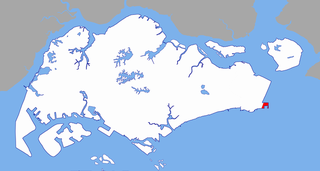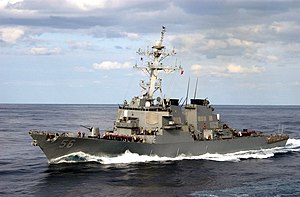
USS Chung-Hoon (DDG-93) is an Arleigh Burke-class Aegis destroyer serving in the United States Navy (USN). Chung-Hoon was named in honor of Rear Admiral Gordon Pai'ea Chung-Hoon (1910–1979), recipient of the Navy Cross and the Silver Star.

The Arleigh Burke class of guided-missile destroyers (DDGs) is a United States Navy class of destroyer centered around the Aegis Combat System and the SPY-1D multi-function passive electronically scanned array radar. The class is named for Admiral Arleigh Burke, an American destroyer officer in World War II and later Chief of Naval Operations. With an overall length of 505 to 509.5 feet, displacement ranging from 8,300 to 9,700 tons, and weaponry including over 90 missiles, the Arleigh Burke-class destroyers are larger and more heavily armed than many previous classes of guided-missile cruisers.

The Seventh Fleet is a numbered fleet of the United States Navy. It is headquartered at U.S. Fleet Activities Yokosuka, in Yokosuka, Kanagawa Prefecture, Japan. It is part of the United States Pacific Fleet. At present, it is the largest of the forward-deployed U.S. fleets, with 50 to 70 ships, 150 aircraft and 27,000 Sailors and Marines. Its principal responsibilities are to provide joint command in natural disaster or military operations and operational command of all US naval forces in the region.

USS Decatur (DDG-73) is an Arleigh Burke-class destroyer in the United States Navy. She is named for the former naval officer Stephen Decatur, Jr. This ship is the 22nd destroyer of her class. USS Decatur was the 13th ship of this class to be built at Bath Iron Works in Bath, Maine, and construction began on 11 January 1996. She was launched on 10 November 1996 and was christened on 8 November 1996. On 29 August 1998 she was commissioned at the Tom McCall Waterfront Park in Portland, Oregon.

USS John S. McCain (DL-3/DDG-36) was the second Mitscher-class destroyer leader in the United States Navy. Commissioned in 1953, she was later converted into a guided missile destroyer and served until 1978. She was sold for scrap in 1979.

USS Curtis Wilbur (DDG-54) is the fourth Arleigh Burke-class guided missile destroyer. Curtis Wilbur was named for Curtis D. Wilbur, forty-third Secretary of the Navy, who served under President Calvin Coolidge. In 2016, she was based at Yokosuka, Japan, as part of Destroyer Squadron 15.

USS Benfold (DDG-65) is a Flight I Arleigh Burke-class destroyer in the United States Navy. She is a multi-mission platform capable of anti-aircraft warfare (AAW) with the powerful Aegis Combat System suite and anti-aircraft missiles, anti-submarine warfare (ASW), with towed sonar array, anti-submarine rockets, anti-surface warfare (ASUW) with Harpoon missiles, and strategic land strike using Tomahawk missiles. Benfold was one of the first ships fitted with the Aegis Ballistic Missile Defense System and during the 2010 Stellar Daggers exercise was the first ship to simultaneously engage a ballistic missile and a cruise missile.

USS McCampbell (DDG-85) is an Arleigh Burke-class destroyer in the United States Navy. She is named in honor of Naval Aviator Captain David S. McCampbell, a Medal of Honor and Navy Cross recipient who was the Navy's leading ace in World War II. This ship is the 35th destroyer of her class. USS McCampbell was the 20th ship of this class to be built by Bath Iron Works at Bath, Maine, and construction began on 16 July 1999. She was launched and christened on 2 July 2000. On 17 August 2002, the commissioning ceremony was held at Pier 30 in San Francisco, California.

USS Momsen (DDG-92) is an Arleigh Burke-class destroyer in service with the United States Navy. Momsen is the twenty-sixth destroyer of the Arleigh Burke class to be built by Bath Iron Works. She is named after Vice Admiral Charles B. "Swede" Momsen of Flushing, Queens, New York (1896–1967). Vice Admiral Momsen made many contributions to the navy such as the invention of the Momsen Lung when he was assigned to the Bureau of Construction and Repair. Momsen was also involved in the first successful rescue of a crew of a sunken submarine, USS Squalus, and subsequently supervised the salvage of the boat.

USS Dewey (DDG-105) is an Arleigh Burke-class guided missile destroyer in the United States Navy. Dewey is the third Navy ship named after Admiral of the Navy George Dewey, hero of the Battle of Manila Bay during the Spanish–American War.

United States Fleet Activities Yokosuka or Commander Fleet Activities Yokosuka is a United States Navy base in Yokosuka, Japan. Its mission is to maintain and operate base facilities for the logistic, recreational, administrative support and service of the U.S. Naval Forces Japan, Seventh Fleet and other operating forces assigned in the Western Pacific. CFAY is the largest strategically important U.S. naval installation in the western Pacific.

USS Haynsworth (DD-700), was an Allen M. Sumner-class destroyer of the United States Navy.

Changi Bay is a planning area located in the geographical region of Tanah Merah in the East Region of Singapore. The planning area is bordered by Changi to the west and the South China Sea to the east, north and south. This planning area also includes the South China Sea island of Pedra Branca.

USS Fitzgerald (DDG-62), named for United States Navy officer Lieutenant William Charles Fitzgerald, is an Arleigh Burke-class destroyer in the US Navy.

USS Michael Murphy (DDG-112) is the 62nd ship of the Arleigh Burke class of guided missile destroyers in the United States Navy. She is named for Medal of Honor recipient Lieutenant Michael P. Murphy (1976–2005). Murphy was posthumously awarded the Medal of Honor for his actions during Operation Red Wings in Afghanistan in June 2005. He was the first sailor awarded the Medal of Honor since the Vietnam War. The ship's name was announced by Secretary of the Navy, Donald C. Winter on 7 May 2008. The ship was christened on 7 May 2011, Murphy's birthday, by her sponsor Maureen Murphy, Michael Murphy's mother. The ship is part of Destroyer Squadron 31 of Naval Surface Group Middle Pacific.

Carrier Strike Group 11 is a U.S. Navy carrier strike group. The aircraft carrier USS Nimitz (CVN-68) is the strike group's current flagship. Other units currently assigned to the group include the cruisers USS Lake Erie (CG-70) and USS Princeton (CG-59), and Destroyer Squadron 9.

Destroyer Squadron 60 is a destroyer squadron of the United States Navy. Destroyer Squadron 60 is one of three U.S. Navy destroyer squadrons permanently based outside the continental United States.
ACX Crystal is a container ship built in South Korea in 2008. In June, 2017, the ship was damaged in a collision with USS Fitzgerald south of Yokosuka, Japan.

Early on 17 June 2017, the United States Navy destroyer USS Fitzgerald collided with MV ACX Crystal, a Philippine-flagged container ship, about 80 nautical miles southwest of Tokyo, Japan; 10 nautical miles southeast of the city of Shimoda on the Japanese mainland (Honshu).

At 5:24 a.m. on 21 August 2017, USS John S. McCain, a United States Navy warship, was involved in a collision with the Liberian-flagged tanker Alnic MC off the coast of Singapore and Malaysia, east of the Strait of Malacca. According to a U.S. Navy press release, the breach "resulted in flooding to nearby compartments, including crew berthing, machinery, and communications rooms." Ten US Navy sailors died as a result of the crash, which prompted the Maritime and Port Authority (MPA) of Singapore to start a multi-agency search-and-rescue (SAR) effort as the agency responsible for coordinating SAR operations within Singapore's Maritime Search and Rescue Region (MSRR). The Singapore Transport Safety Investigation Bureau (TSIB) also launched a marine safety investigation following the collision in accordance with the International Maritime Organisation's Casualty Investigation Code in Singapore's capacity as a coastal state, and published its final report on 8 March 2018. The U.S. Navy announced on 24 August 2017 that it had suspended search-and-rescue efforts for survivors in the open sea to focus on the recovery of the remains of the missing sailors still inside the flooded compartments of the ship. By 27 August, U.S. Navy and United States Marine Corps divers had recovered the remains of all ten sailors. On 12 September 2017, the United States' chargé d'affaires Stephanie Syptak-Ramnath expressed thanks for Singapore's support during the SAR operations. The McCain returned to service in June 2020.
























